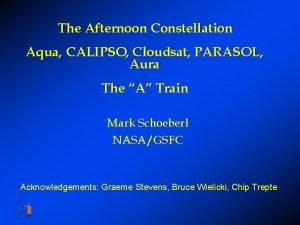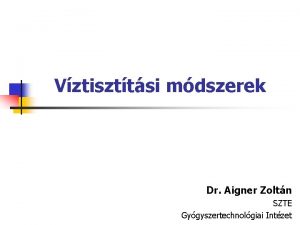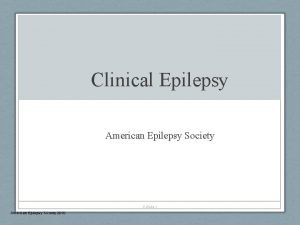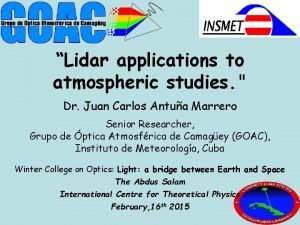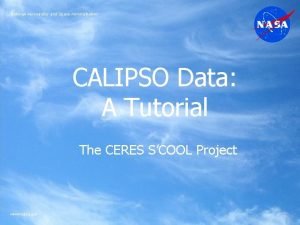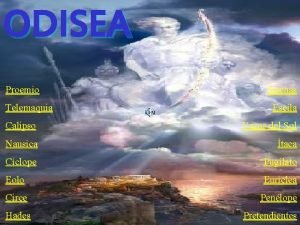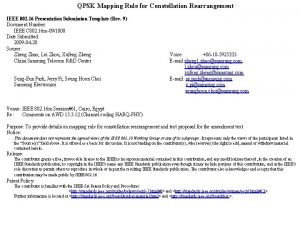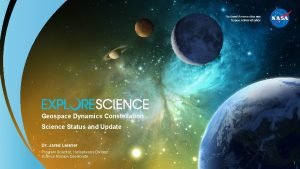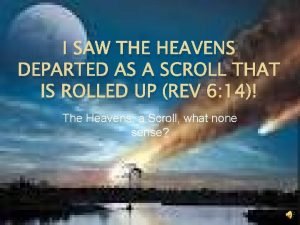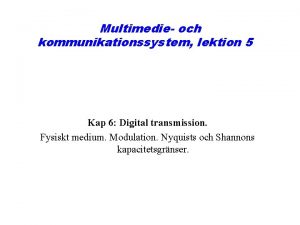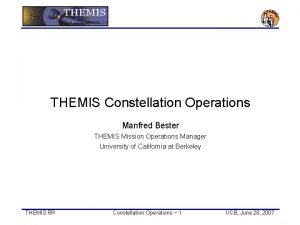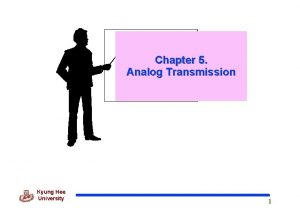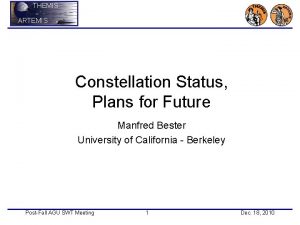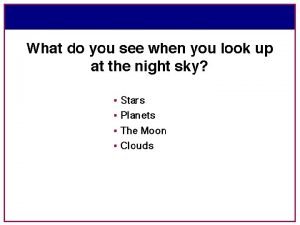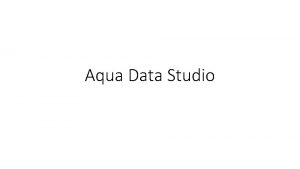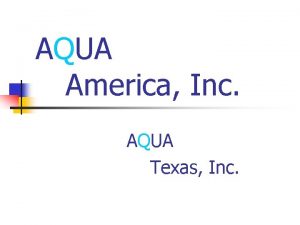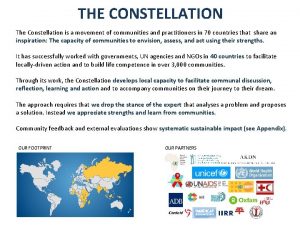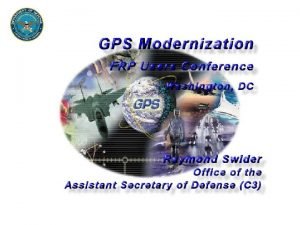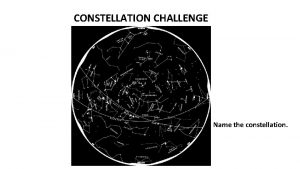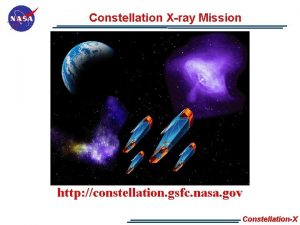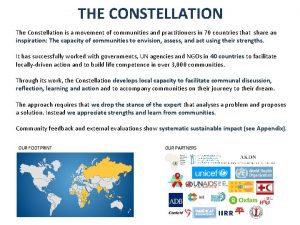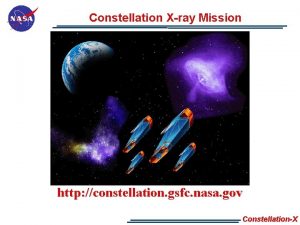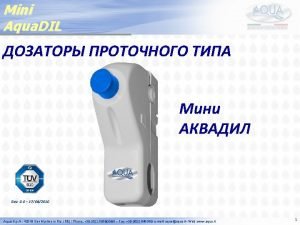The Afternoon Constellation Aqua CALIPSO Cloudsat PARASOL Aura
















- Slides: 16

The Afternoon Constellation Aqua, CALIPSO, Cloudsat, PARASOL, Aura The “A” Train Mark Schoeberl NASA/GSFC Acknowledgements: Graeme Stevens, Bruce Wielicki, Chip Trepte

The Aqua/Aura Afternoon Constellation The “A” Train 1: 38 PM Aura 1: 30 PM Cloudsat PARASOL MI - Cloud heights MI & HIRLDS – Aerosols MLS& TES - H 2 O & temp profiles MLS & HIRDLS – Cirrus clouds EOS “A Train” CALIPSO Aqua CALPSO- Aerosol and cloud heights MODIS/ CERES Cloudsat - cloud droplets IR Properties of Clouds PARASOL - aerosol and cloud polarization AIRS Temperature and H 2 O Sounding

CAL IP SO C Cloudsat will “orbit”CALIPSO, both loosely following Aqua EOS “A Train” ontro Aqua Cloudsat CALIPSO PARASOL Aura l Box

Aqua • Sun - synchronous, polar • Altitude - 705 km nominal • Inclination - 98. 2 +/- 0. 1 degrees • Ascending node - 1: 30 p. m. +/- 15 minutes • Period - 98. 8 minutes • Launched - May 4, 2002 Instruments • Atmospheric Infrared Sounder (AIRS) • Advanced Microwave Sounding Unit (AMSU) • Humidity Sounder for Brazil (HSB) • Advanced Microwave Scanning Radiometer-EOS (AMSR-E) • Clouds and the Earth's Radiant Energy System (CERES) • Moderate Resolution Imaging Spectroradiometer (MODIS) EOS “A Train”

CALIPSO (formerly Picasso-CENA) Cloud-Aerosol Lidar and Infrared Pathfinder Satellite Observation IIR 20 km Laser WFC LITE measurements over convection 10 0 Distance • 2 -wavelength (532 and 1064 nm) polarization-sensitive LIDAR that provides 30 m vertical resolution profiles of aerosols and clouds. • Imaging infrared radiometer (IIR) that provides calibrated infrared radiances at 8. 7 µ, 10. 5 µ and 12 µ. These wavelengths are optimized for combined IIR/lidar retrievals of cirrus particle size. • High-resolution wide field camera (WFC) that acquires high spatial resolution imagery for meteorological context (620 to 670 nm). EOS “A Train”

Cloudsat 94 GHz Cloud Profiling Radar (CPR) • Nadir-viewing • 500 m vertical resolution • 1. 2 km cross-track, 3. 5 km along track • Sensitivity: -30 to -36 d. BZ Data Products • Radar reflectivity • Visible and near-IR radiances • Cloud base and top heights • Optical depth • Atmospheric heating rates • Cloud water content • Cloud ice content • Cloud particle size • Precipitation Occurrence EOS “A Train”

PARASOL POLDER Instrument Polarization and Directionality of the Earth's. Reflectances Polarization and Anisotropy of Reflectances for Atmospheric Science coupled with Observations from a LIDAR POLDER is a push broom, wide field of view, multi-band imaging radiometer/polarimeter, 114 -degree wide field of view, 7 km x 6 km footprint. A filter/polarizer wheel rotates and scans eight narrow spectral bands in the visible and near infrared (443, 490, 565, 665, 763, 765, 865 and 910 nm), and threepolarization angles for select wavelengths. EOS “A Train”

Aura Atmospheric Chemistry and Climate: Launch mid-2003 • High Resolution Dynamics Limb Sounder (HIRDLS: USA) – Measures IR limb emission of trace gases and aerosols • Microwave Limb Sounder (MLS: USA) – Measures microwave limb emission of ozone destroying chemicals • Tropospheric Emission Spectrometer (TES: USA) – Down looking and limb looking measurements of air pollution • Ozone Monitoring Instrument (OMI: Netherlands) – Measures global ozone change M LS HIRDLS OMI EOS “A Train” TES Direction of flight

“A-Train” Nadir Footprints 6 x 7 km POLDER 1. 4 km Cloudsat 0. 5 km MODIS Band 3 -7 0. 09 km CALIPSO Cloud 13. 5 km AIRS IR; AMSU & HSBm wave Washington DC USGS EOS “A Map Train” 5. 3 x 8. 5 km TES 2. 3 km AIRS 0. 4 -1 m

Vertical Resolution of the “A Train” Aura Aqua 30 CALIPSO Cloudsat 25 20 15 10 Km 5 0 MLS 1. 5 -2 HIRDLS TES 1. 5 2. 3 AMSU AIRS HSB 1 2 Vertical resolution in km EOS “A Train” 0. 03 0. 5

A-Train Science Aqua/ CALIPSO /Cloudsat/Parasol/Aura • What are the aerosol types and how do observations match aerosol global emission & transport models? – CALIPSO aerosol height information + Aqua/MODIS & POLDER to get aerosol size distribution and composition • How do aerosols contribute to the Earth radiation budget/ climate forcing? – CALIPSO aerosol height information + MODIS & POLDER size distributions + Aqua CERES for Earth Radiation budget • How does cloud layering effect the Earth Radiation budget? – Cloudsat + CALIPSO + MODIS provides cloud height and thickness information; CERES provides Earth Rad. Budget • What is the role of Polar Stratospheric Clouds in ozone loss anddenitrification of the Arctic vortex? – CALIPSO + Aura/HIRDLS cloud height measurement + Aura MLS Ozone, Temperature, HNO 3 and Cl. O • What is the vertical distribution of cloud water/ ice in cloud systems? – Cloudsat + Aura/MLS + Aqua/HSB & AMSR/E EOS “A Train”

“A” Train Correlative Measurements • AIRS/HSB/AMSU and MLS - upper tropospheric water vapor – MLS: Upper tropospheric O 3, H 2 O, Cirrus ice - 1. 5 km vertical resolution ~ 7. 5 minutes behind Aqua (fraction of ppm accuracy) – HIRDLS 22. 5 minutes behind- upper trop. down to cloud tops, 1 km vertical res. • MODIS, PARASOL and OMI - aerosols and clouds – PARASOL gets polarization from different angles which can be used to identify aerosol types – OMI gets UV absorbing aerosols (smoke, dust and sulfates) – MODIS gets small and large aerosol concentration • HIRDLS and CALIPSO – HIRDLS makes limb IR aerosol measurements with vertical resolution of 1. 5 km – CALIPSO makes aerosol measurements to 30 m • TES and AIRS - Spectral information • TES: Spectral Coverage 3. 2 - 15. 4 mm, 0. 025 cm -1 resolution • AIRS: Spectral Coverage 3. 4 - 15. 4 mm, resolution ~1 cm -1 EOS “A Train”

Summary of the “A” Train • The Formation – Aqua (1: 30 PM )and Aura (1: 38 PM)) must maintain groundtrack on the WRS (± 20 km) using frequent burns (once every 3 months) – Cloudsat and CALIPSO ~20 seconds (~140 km) behind Aqua within a control box 40 seconds wide. Near end of mission, CALIPSO drifts (left) across MODIS swath. – PARASOL is roughly lined up Aqua about 3 minutes behind – Aura is 15 minutes behind Aqua (crossing time is 1: 38 PM) • The Science – Unprecedented cloud science – Unprecedented climate/aerosol/chemistry science – Correlative measurements • Challenges – Variety of vertical and horizontal resolutions which will be challenging to match EOS “A Train”

Backup EOS “A Train”

Formation Flying with Aqua Aura and Aqua have different WRS paths. TES Limb track MODIS 1150 km Airs 825 km Aqua Orbit Plane MLS Limb track N Ground track (WRS Path) ~2500 km 15 min (~ 52 o lat) CALIPSO Cloud Sat PARASOL CALIPSO/Cloudsat ~2 minutes behind Aqua Parasol is 3 minutes behind Aqua 373 km 7 min (~ 26 o lat) Aura ~2500 km 73 km 197 km Equator OMI 1300 km 172 km TES Limb track 7 min OMI swath is larger than MODIS or AIRS EOS “A Train” ~394 km 1000 km 2000 km HIRDLS scan

Aqua’s Temperature and Moisture Sounding Suite AMSU (Temperature and moisture profiles) 15 discrete channels in the range of 50 to 89 GHz AIRS (Temperature & moisture profiles, cloud properties) AMSR/E (Cloud properties, precipitation, total moisture) 12 channels at six discrete frequencies in the range of 6. 9 to 89 GHz MODIS (Cloud and aerosol properties etc. ) 36 spectral bands from 0. 4 to 14 2, 300 spectral channels in the range µm of 0. 4 to 1. 7 µ and 3. 4 to 15. 4 µm HSB (Moisture profiles) 5 discrete channels in the range of 150 to 183 MHz EOS “A Train” CERES (Radiant energy flux) Two sensor, one scanning cross track, the other scanning azimuthally view in three channels per scanner: shortwave (0. 3 to 5 µm), longwave (8 to 12 µm), and "total" (0. 3 to > 50 µm)
 Aura parasol
Aura parasol Aqua demineralisata
Aqua demineralisata Syncope vs seizure
Syncope vs seizure Calipso isu
Calipso isu Nasa www.nasa.gov
Nasa www.nasa.gov Odisea
Odisea Rule constellation
Rule constellation Orion the hunter constellation
Orion the hunter constellation Family constellation definition
Family constellation definition Geospace dynamics constellation
Geospace dynamics constellation Mazzaroth
Mazzaroth 8 qam constellation
8 qam constellation Themis constellation
Themis constellation Find constellation
Find constellation Artemis constellation
Artemis constellation Astronomical coordinates
Astronomical coordinates Ask modulation constellation diagram
Ask modulation constellation diagram
